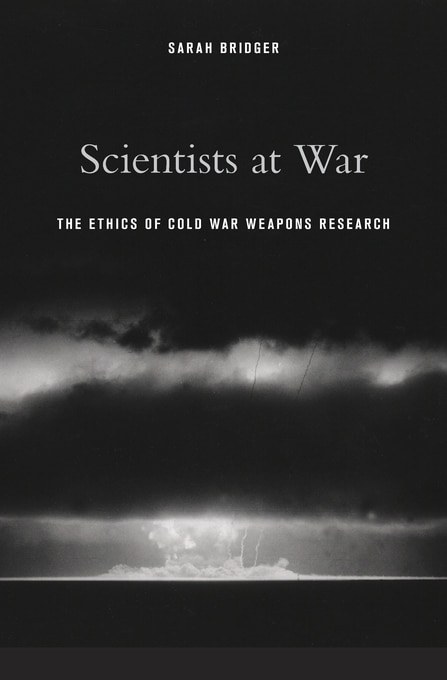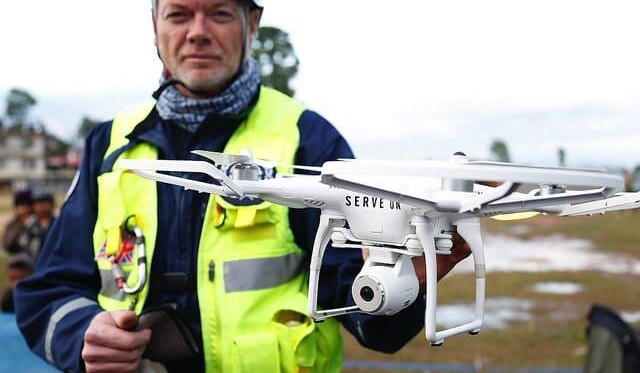 Scientists at War: The Ethics of Cold War Weapons Research, Sarah Bridger
Scientists at War: The Ethics of Cold War Weapons Research, Sarah Bridger
(Cambridge: Harvard University Press, 2015), 368 pp., $45 cloth.
doi:10.1017/S0892679416000162
In this important new work, historian Sarah Bridger explores the ambivalent role of scientists in U.S. policy debates over national defense issues from the 1950s to the 1980s. This is a significant contribution to our understanding of the evolution of the scientific professions in the shadow of the national security state.
Scientists at War focuses primarily on two important questions. The first is: How did cold war–era American scientists understand their political responsibility? In other words, to what extent did they consciously weigh political and ethical considerations before agreeing to conduct weapons-related research? Bridger’s answer is that American scientists—especially high-profile scientists working at the country’s most prestigious institutions—embraced an ethic of responsibility that set limits on how far they would go to satisfy the desires of the government. This ethic of responsibility caused the scientists to take increasingly public and forceful political stances against what they saw as escalating U.S. belligerence.
Whereas in the 1950s and early 1960s elite scientists generally felt honored to be called to public service and did not withdraw from it even when the government made choices with which they did not agree, starting in the late 1960s many began to drop out of government service because they were frustrated by the ever-escalating militarized confrontation with communism. By the early 1980s these scientists were so disenchanted with the direction of U.S. defense policy that they became willing to enlist their professional associations overtly in opposition to it. In particular, they became full-throated opponents of the Reagan administration’s “Star Wars” Strategic Defense Initiative (SDI), a project they deemed technically, strategically, and ethically wrong.
The book’s second major question is: How much influence did the scientists actually exercise over the direction of U.S. policy? In other words, did their sense of political responsibility have an impact on anything other than their own consciences? Bridger argues that it did. For instance, she demonstrates that Kennedy-era presidential science advisor Jerome Wiesner’s tireless efforts were crucial for the creation of the 1963 Partial Test Ban Treaty. She also shows how the patient prodding of presidential science advisor Lee DuBridge and other scientists pushed the Nixon administration to support ratification of the 1925 Geneva Protocol on chemical and biological warfare and to curtail the use of chemical defoliants in the war in Southeast Asia. However, Bridger notes that by the Nixon era the scientists’ power was already waning, and by the 1980s it was almost entirely gone. Therefore, not even the highly impressive mobilization of scientists and their professional associations against SDI in the 1980s was able to prevent the government from committing massive resources to that technical misadventure.
Thus, on the one hand, Bridger finds the scientists expressing their national security policy views with increasing force and formality; on the other hand, she finds them exerting a decreasing impact on the ultimate course of U.S. defense policy. This pair of conclusions might seem paradoxical, but in fact they can be seen as two sides of the same coin. As long as the scientists generally supported the U.S. policy of militarized confrontation with communism, they were able to convince different administrations to make course corrections. But the more they expressed fundamental disagreement with the government’s policy direction, the less the government listened to them. The causal arrow also points in the other direction: the more the government turned a deaf ear to the scientists’ suggestions, the stronger their opposition to it became. The deeper structural question, however, is why the U.S. government was increasingly able to ignore the scientists’ opinions even as it came to rely more and more on high technology to maintain its military edge. Bridger suggests, but only in passing, that the answer lies in the diffusion of defense R&D beyond the traditional elite universities and national labs. As the elite institutions lost their monopoly on the relevant scientific expertise, they also lost their political punch. Indeed, Bridger argues that the state’s frustration with the political pretensions of the academic elites partially explains why it began to turn toward “the entrepreneurs and managers of new spinoff defense firms and the administrators of large second-tier universities hoping to cash in on whatever defense moneys might be made available” (p. 220).
This structural argument about the effects of what Bridger terms the new “social geography of defense research” (p. 221) is one of the more provocative and interesting in the book, but it is not entirely convincing. One reason for skepticism is that Bridger focuses on just one portion of the scientific community: the elite scientists. It is their papers that she has read and their evolving positions that she traces—and she traces them very well. But if the rise of second-tier universities and private research institutes really did change the political dynamics of weapons research during the cold war, then Bridger should have delved just as deeply into the ideas and actions of people working in those places. For instance, is it really true that the second-tier university scientists did not worry as much about their political responsibility as did their first-tier colleagues? My hunch is that many of them would beg to differ with this characterization.
Moreover, as a theoretical matter it is not obvious that the geographical dispersion of federal research dollars from the urban Northeast and far West to the South, the Midwest, and the suburbs should have undermined the elite scientists’ power. In the political science literature on interest group politics—we can think of scientists as an interest group—there are three standard theories about the impact of a group’s geographic concentration on its political power. The first theory is that geographic concentration promotes the group’s influence, because concentration makes it easier to overcome the collective action problem. That is the theory that Bridger implicitly endorses. But there is also an alternative theory that holds that geographic dispersion promotes the group’s influence, because dispersion makes the group’s concerns relevant to a greater number of legislators. And then there is a synthetic theory, put forth most systematically by Cheryl Schonhardt-Bailey, which sees the ideal formula as a combination of concentration at the top and dispersion at the base.
The evolution of the American system of higher education since World War II would seem to reflect this third situation. The second-tier universities grew by leaps and bounds, but they still remained largely dependent on the elite institutions when hiring faculty and determining the most promising research avenues. The academy’s pyramidal structure was also evident in the elite institutions’ continuing dominance of the main scientific professional associations, as Bridger indicates in her discussion of the American Physical Society during the Vietnam era (p. 194). In light of these structural trends, the elite scientists were seemingly well positioned to become increasingly politically powerful over time. But, in fact, their power waned. Why?
One possible alternative explanation for the scientists’ declining political influence after the 1960s is latent in Bridger’s case studies of the advisory committees that Vietnam-era Princeton and MIT created to define the proper relationship between their respective institutions and the national security state. Comprised of regular teaching faculty (including, in the MIT committee, Noam Chomsky) and student representatives, these committees made important decisions that shaped the future of defense-related R&D at their institutions. From the perspective of 2016, it seems almost a fairy tale that once upon a time the faculty and students at major universities had the power to set the conditions under which any of their colleagues could take money from the Pentagon.
What I think these case studies implicitly suggest about the decline in the professors’ national political power is that it may have been a consequence of their cession of power within their home institutions. The less the universities operated according to the principle of faculty self-governance, the less the national security establishment had to deal with the professors and their pesky ethical concerns. Instead, by the 1980s it was primarily university administrators who interfaced with government officials, and their ways of thinking were very closely aligned. Thus, even on the increasingly rare occasions when the elite scientists did find themselves fully engaged in questions of national security policy—as in the case of Reagan’s SDI proposal—they had insufficient power to enforce their views.
A second possible alternative hypothesis is that the scientists’ political decline after the 1960s may have been the result of broad societal changes occurring outside the ivory tower. Perhaps the most consequential of these changes was the resurgence of religion, and especially evangelical Christianity, to the forefront of the American political scene. Scientists’ political power in modern societies is based fundamentally on the rationalist assumption that they have a special insight into the truth about the world. But starting in the mid-1970s that assumption was strongly contested in the United States by an alternative vision of truth grounded in a literalist interpretation of the Bible. Indeed, as Thomas Goodnight and other scholars of rhetoric have shown, an essential component of Reagan’s political personality was his hard turn away from scientific-rationalist discourse in favor of religious-mystical discourse. This rhetorical revolution was particularly noticeable in his national security policy addresses. Reagan’s faith-based appeals resonated strongly with many less well-educated, working-class white voters in the South and noncoastal states, who quickly became the core support base for the Republican party—a situation that has persisted to the present day.
The displacement of science as the main arbiter of truth in the U.S. political debate could not fail to undermine the political power of scientists. This new situation was particularly evident in Reagan’s—and over time his entire party’s—fierce embrace of the technically unworkable SDI proposal. Unfortunately, Bridger’s discussion of the SDI focuses narrowly on the debates among scientists, and therefore misses this larger narrative. Bridger is certainly right to point out that the renowned physicist Edward Teller and a handful of his colleagues were the people who originally sold Reagan on the idea of impermeable space-based defenses, and that the Reagan team subsequently found a few additional scientist supporters who were willing to create the appearance of technical plausibility for the project. Bridger also aptly notes the irony in the right-wing scientist-activists’ appropriation of the Vietnam War–era peace movement’s arguments about the inherent political bias in funded scientific research. In this way, they effectively blunted the political impact of the attacks by mainstream scientists on the technical plausibility of SDI. But it is hard to imagine that anything the mainstream scientists could have said or done would have convinced Reagan and his followers to give up on SDI, willing as they were to bend or break the laws of physics in pursuit of a higher calling. In short, the scientists’ anti-SDI activism may have been defeated not primarily by “merchants of doubt,” as Bridger contends (p. 259), but rather by merchants of faith.
The author is associate professor of international relations at the University of Southern California. His latest book is Achieving Nuclear Ambitions: Scientists, Politicians, and Proliferation (2012).
More in this issue
Summer 2016 (30.2) • Essay
Patti Tamara Lenard Replies
Is the revocation of citizenship—a policy increasingly adopted by democratic states—a violation of democratic principles? In an article published in the Spring 2016 issue ...
Summer 2016 (30.2) • Essay
Lost in Transformation? The Politics of the Sustainable Development Goals
On September 25, 2015, the world’s leaders adopted a new suite of development goals—the Sustainable Development Goals (SDGs)—that are to guide policymakers for the ...

Summer 2016 (30.2) • Essay
The Possibilities and Pitfalls of Humanitarian Drones
What comes to mind when we hear the word “drone”? For many of us, it is the image of a General Atomics MQ-1B Predator ...